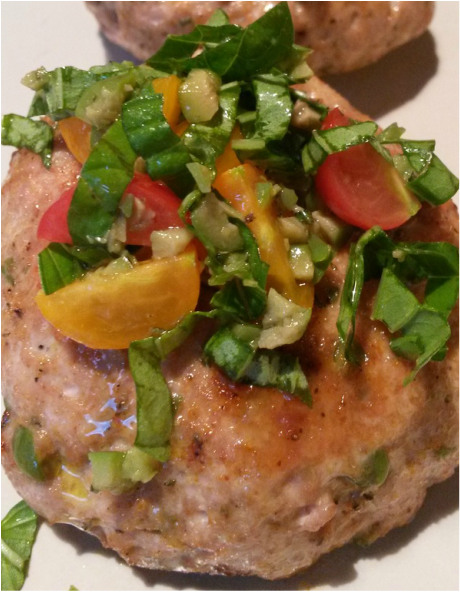Most turkey burgers are tasteless, dry, and defined by the condiments we smear between them and the bun. With this recipe, a savory burst of brightness infuses each bite. Ancho’s light spice, lemon’s uplift, garlic’s tang, rosemary’s floral aroma, and Castelvetrano olives’ buttery brine combine to create a bold and moist burger. While many Fourth of July partygoers prefer to have a bun with their burger, these patties can hold their own, especially when topped with caramelized onions, homemade pesto, a juicy tomato slice, or a confetti of chopped olives, quartered cherry tomatoes, and sliced basil leaves (see the photo).
Serves 4-5
1 tablespoon fresh rosemary, finely chopped
1 tablespoon garlic, finely chopped
1 tablespoon lemon zest, finely chopped
2 teaspoons ground Ancho chili
1-2 teaspoons salt (to taste)
1 teaspoon black pepper
2 pounds ground turkey, organic or sustainably raised
Optional: 3 tablespoons Castelvetrano olives, roughly chopped
1 tablespoon olive oil (to prevent the burgers from sticking to the baking dish)
1. Preheat the oven to 400 degrees Fahrenheit.
2. Place all of the ingredients in a stainless steel bowl.
3. Wash your hands thoroughly, or put on food safe gloves. With your hands, mix together all of the ingredients.
4. Form the mixture into 4-5 ounce patties.
5. Place the patties in an oiled baking dish.
6. Discard the gloves and wash your hands.
7. Place the burgers in the oven and bake for about 6-8 minutes before turning them over. Continue to cook the patties for another 6-8 minutes or until they are cooked through (but not overcooked and, therefore, dry).
6. Let the patties sit for 3 minutes after they come out of the oven, and garnish with the topping of your choice.
*I bake these burgers for health reasons. The traditional grill’s intense char has the potential to cause cancer (prostate and breast—see The New Prostate Cancer Nutrition Book), and the flat grill’s heat concentration can develop a dense crust that may not be the best to ingest. By baking the burgers, you can form an appetizing crust while proving a more gentle heat for the meat.

 RSS Feed
RSS Feed